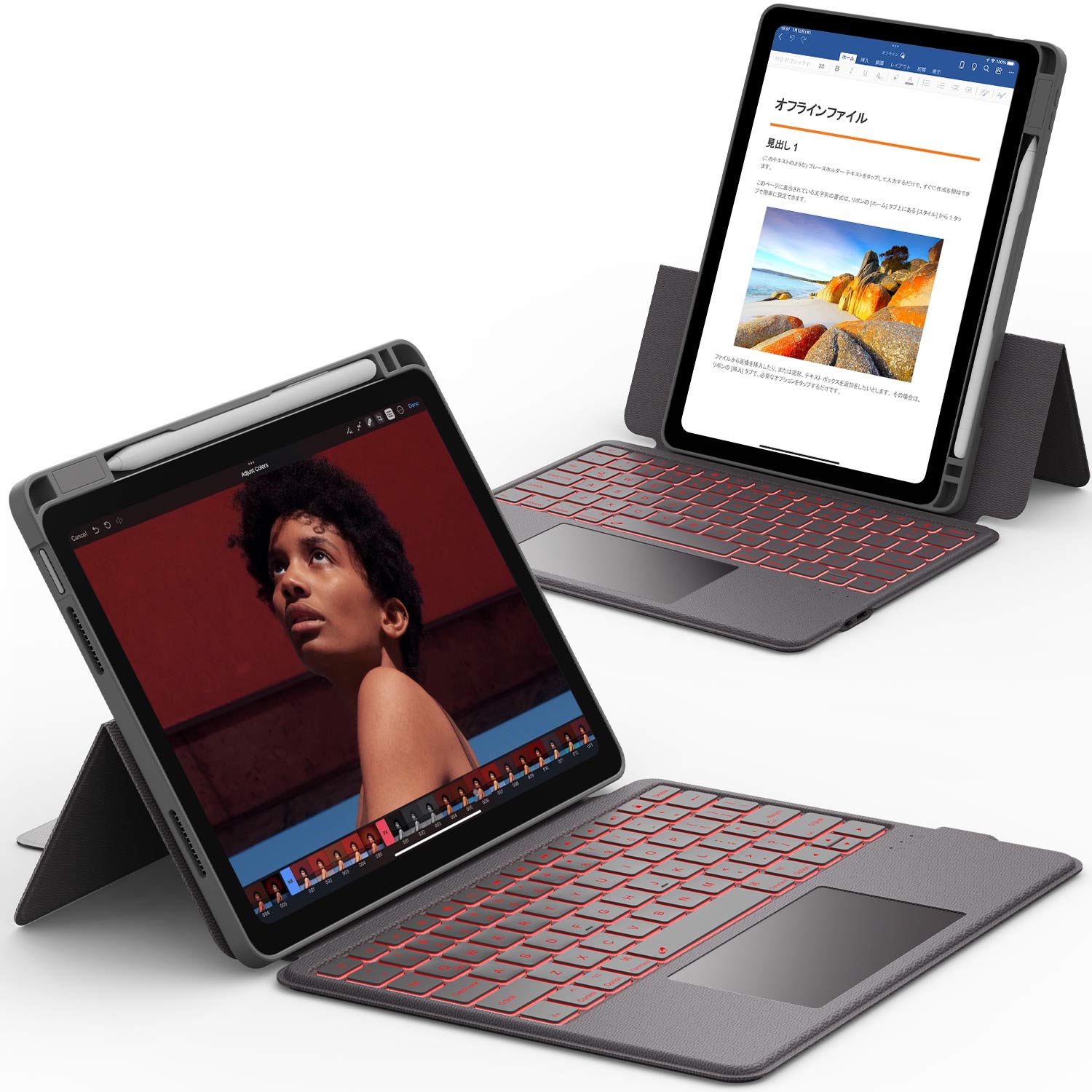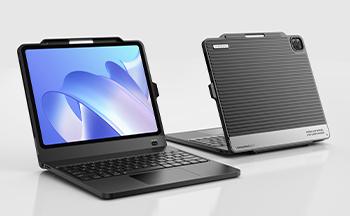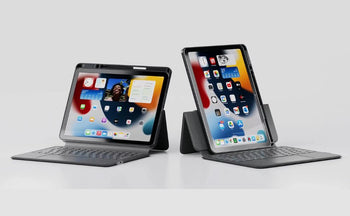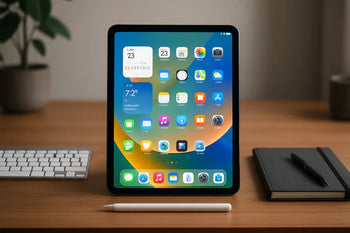Does your iPad camera keep moving and following you during video calls? This happens because of a feature called Center Stage that automatically keeps you in the frame.
You can turn off this camera following feature by going to Settings, then Camera, and switching off Center Stage.
Many iPad users find this automatic tracking unsettling or distracting. The camera zooms and pans independently to follow your movements, which can feel intrusive during important calls or recordings.
This guide will walk you through the simple steps to disable Center Stage completely. You'll also learn which iPad models support this feature, how to re-enable it if needed, and what to do if the camera still follows you after making changes.
Quick Insights 💡:
- The feature is called Center Stage
- Go to Settings > FaceTime > Center Stage > Toggle Off
- Or turn it off directly in apps like Zoom or Teams
- You can switch it on/off anytime
- Works on iPad Pro, iPad Air, and newer iPad models
Why Does the iPad Camera Follow You?
Your iPad camera follows you because of a feature called Center Stage. This feature is built into newer iPad models to enhance video calling.

Center Stage uses your iPad's ultra-wide camera and smart AI technology. The camera takes a wide view of the room. Then, the AI decides which part of the wide view to display on screen.
When you move around, the AI tracks your face and body. It automatically adjusts the camera view to keep you centered on the screen. This issue occurs during FaceTime calls and other video conferencing apps.
The system works by:
- Using the ultra-wide camera to see more of the room
- Tracking your movements with AI software
- Cropping the video to follow you around
- Keeping you centered in the frame automatically
Some users find this feature distracting. The camera view moves and adjusts constantly as you shift in your seat. This can make video calls feel unsteady.
Others don't like feeling watched or tracked. The camera seems to "follow" your every move. This can feel uncomfortable during long video meetings.
The feature also doesn't work well if multiple people are on camera. It may zoom out too far or focus on the wrong person. This can make group calls awkward.
Also Read: iPad Air 2 vs iPad 5th Gen: Key Differences & Full Comparison
How to Stop iPad Camera from Following You
The Center Stage feature makes your iPad camera track your movements during video calls. You can turn this off through your iPad settings, disable it during active calls, or control it for specific apps.
Method 1 – Turn Off Center Stage in Settings
Open the Settings app on your iPad. Look for Camera in the left menu and tap it.
You will see a toggle switch labeled Center Stage. Tap the switch to turn it off. When it's off, the switch will be gray instead of green.
This setting affects all apps that use your front camera. Once you turn it off here, your camera will stay in one position during video calls.
The setting stays off until you turn it back on. You can always go back to Settings and flip the switch again if you change your mind.
Some newer iPad models have this feature built into the hardware. If you don't see Center Stage in your Camera settings, your iPad might not support this feature.
Method 2 – Turn Off During Video Calls
Most video calling apps let you turn off Center Stage while you're on a call. Look for a camera icon or video settings button during your call.
- In FaceTime: Tap the screen during a call. Look for the Center Stage button, which looks like a rectangle with arrows. Tap it to turn the feature off.
- In Zoom: Start or join a meeting. Tap the screen and look for video controls. Find the Center Stage option in the video settings menu.
- In Microsoft Teams: During a call, tap the three dots menu. Look for camera options and find the Center Stage toggle.
- In Google Meet: Tap the screen during a call. Look for camera settings in the menu and turn off Center Stage from there.
The setting you pick during a call might reset when you start a new call. Each app handles this differently.
Method 3 – Control Per-App Settings
Some apps remember your Center Stage choice for future calls. Other apps reset to the default setting each time you use them.
Apps like FaceTime and Zoom often save your preferences. If you turn off Center Stage in these apps, it usually stays off for your next call.
When to keep Center Stage on:
- Group video calls where you move around
- Presentations where you point to things
- Cooking or tutorial videos
When to turn Center Stage off:
- Professional meetings where you stay still
- Recording videos with a fixed frame
- When you want full control of your camera angle
Check each app's video settings to see if it has its own Center Stage control. This lets you have different settings for different apps based on how you use them.
Also Read: How to Connect External Display to iPad: A Simple Guide
How to Re-Enable Center Stage if Needed

You can turn Center Stage back on using the same methods you used to disable it. This feature works well for video calls when you need to move around while staying in the frame.
Restoring Center Stage in Settings
Open Control Center by swiping down from the top-right corner of your iPad screen. Look for your video app controls at the top of Control Center.
Tap the app name button (like "FaceTime Controls" or "Zoom Controls"). You will see the Center Stage option, which features a toggle switch.
Tap the Center Stage button to turn it back on. The button will highlight when the feature is active.
You can also enable Center Stage directly within your video calling app. Most apps, such as FaceTime, Zoom, and Google Meet, display the Center Stage toggle in their video settings during calls.
Situations Where Center Stage Is Useful
Center Stage works best during video calls when you need to move around. The camera automatically follows you and keeps you centered in the frame.
This feature helps during cooking videos or presentations where you step away from your iPad. It also works well for group calls where multiple people move in and out of the camera view.
Parents find Center Stage helpful when kids join video calls with grandparents. The camera tracks the children as they move around the room.
The feature uses machine learning to detect your movements. It works with the iPad's ultra-wide front camera to pan and zoom automatically.
Troubleshooting: When the iPad Camera Still Follows You
Sometimes, the camera continues to follow you even after you turn off Center Stage. A device restart and software updates can often resolve most problems, but Apple Support can assist with issues that persist.
Restarting Your iPad and Updating Software
A simple restart often resolves many camera issues on your iPad. Press and hold the power button and the volume up button simultaneously. Wait for the power slider to appear, then drag it to turn off your device.
Wait 30 seconds before turning your iPad back on. This clears temporary files that might be causing Center Stage to stay active.
Check for software updates next. Open Settings and tap General. Select Software Update and install any available updates.
Outdated software can cause camera features to work incorrectly. New updates often fix bugs with Center Stage and other camera functions.
After updating, test your camera in FaceTime or another video app.
The following steps can help verify the fix:
- Open a video calling app
- Check if the camera still moves
- Look for Center Stage settings in Control Center
- Test with different apps to confirm
Also Read: How to Update iPad: A Guide for the Latest iPadOS
Contacting Apple Support for Persistent Issues
Contact Apple Support if your camera continues to follow you after trying basic fixes. Hardware problems or deep software issues might need professional help.
Visit Apple's website or use the Apple Support app on your device. You can also call Apple directly or visit an Apple Store.
- Before contacting support, gather this information:
- Your iPad model and iOS version
- When the problem started
- Which apps show the issue
- Steps you already tried
Apple Support can run remote tests on your device. They might suggest a factory reset or hardware repair if needed. Keep your device backed up before trying any major fixes they recommend.
Which iPad Models Have Center Stage?
Center Stage is compatible with iPads featuring the M1 chip and newer models. This feature requires special hardware to work properly.
The following iPad models have Center Stage:
- iPad Pro 11-inch (2021 and newer)
- iPad Pro 12.9-inch (2021 and newer)
- iPad Air (5th generation and newer)
- iPad (9th generation and newer)
- iPad Mini (6th generation and newer)
These models use the ultra-wide front camera to track your movements. The camera automatically keeps you centered during video calls.
If you have an older iPad model, you won't see the Center Stage option. Only newer iPads have the right camera and processing power for this feature.
You can check if your iPad has Center Stage by opening the Control Center during a video call. Look for the Center Stage button in the camera controls.
The feature works with apps like FaceTime, Zoom, and Teams. It uses artificial intelligence to detect and follow people in the camera view.
Pros and Cons of Center Stage
Center Stage has both benefits and drawbacks. Here are the main points to consider.
Pros:
- Auto-adjusts for movement - The camera follows you as you move around during video calls
- Great for group calls - Multiple people can stay in frame as they join or leave the conversation
- Hands-free operation - You don't need to manually adjust the camera position
- Professional appearance - Keeps you centered and properly framed without effort
- Works with presentations - You can move around while teaching or presenting
Cons:
- Can be distracting - The constant camera movement might feel unnatural to you or viewers
- Drains battery slightly - The feature uses extra processing power which affects battery life
- Reduces manual control - You can't choose your exact camera angle or position
- May cause motion sickness - Some people find the automatic movements uncomfortable to watch
- Privacy concerns - The camera actively tracks your movements even when you don't want it to
The feature works well for active video calls. However, it might not suit everyone's preferences.
Some users prefer a fixed camera position. Others love the automatic tracking during busy calls.
Your choice depends on how you use your iPad for video calls. Consider your typical call setup and personal comfort level.
Tips for Better iPad Camera Use
Getting the most out of your iPad camera takes some simple steps. These tips will help you take better photos and have clearer video calls.
👉 Use a stand for steady video calls. This keeps your iPad in the right spot and stops shaky footage. Your hands stay free during calls too.
👉 Adjust the lighting for a clearer picture. Face a window or bright light source when possible. Avoid sitting with bright lights behind you. Good lighting makes your face look clear and natural.
👉 Keep the lens clean for the best quality. Wipe the camera lens with a soft cloth before taking photos or starting video calls. Fingerprints and dust make pictures look blurry.
Here are more helpful tips:
- Hold your iPad with both hands when taking photos
- Tap the screen to focus on what you want to capture
- Use the volume buttons as a shutter for easier photos
- Turn on grid lines in camera settings to frame shots better
- Get closer to your subject instead of using digital zoom
- Try different angles for more interesting photos
Check your camera app permissions in Settings if something is not working right. Some apps need permission to use your camera.
Update your iPad regularly to get the newest camera features and fixes. Apple often improves camera performance with updates.
These simple changes will make your iPad camera work much better for photos and video calls.
Conclusion
That unsettling feeling of your iPad camera autonomously tracking your movements has a simple explanation and an even simpler solution.
We've shown you how to stop iPad camera from following you by disabling the Center Stage feature, either temporarily during a call or permanently in your Settings.
Remember, the key is knowing where to find the Video Effects control or the main Center Stage toggle. Taking control of your device's features is the best way to ensure your comfort and privacy.
Final Thought: Technology should work for you, not the other way around. Don't hesitate to customize features like Center Stage to suit your preferences.
👉 Want to upgrade your iPad experience? Check out these collections for stylish, functional cases:
FAQs About How to Stop iPad Camera from Following You
iPad users often have questions about camera tracking features and privacy settings. These common concerns cover turning off facial tracking, understanding Center Stage compatibility, and managing app-specific camera behaviors.
How do I turn off facial tracking on my iPad?
You can disable facial tracking by turning off the Center Stage feature. Open Settings and tap Camera.
Find the Center Stage option and toggle it off. This stops the camera from automatically following your face during video calls.
You can also turn off Center Stage directly in FaceTime. Look for the Center Stage button during a call and tap it to disable the feature.
Do iPad cameras follow you?
iPad cameras with Center Stage do follow you during video calls. This feature uses machine learning to keep you centered in the frame.
The camera digitally pans and zooms to track your movement. It only works when you're using video calling apps or recording.
Your iPad camera does not follow you when apps aren't actively using it. The tracking only happens during video sessions.
What does it mean to stop trackers from profiling you?
Stopping trackers means preventing apps from collecting data about your camera usage patterns. You can control which apps access your camera through Settings.
Go to Settings, then Privacy & Security, then Camera. Turn off camera access for apps you don't want using it.
This prevents apps from building profiles based on your video call habits or camera usage.
Does Center Stage work on all iPads?
Center Stage only works on newer iPad models with advanced front-facing cameras. It's available on iPad Pro 11-inch (3rd generation and later) and iPad Pro 12.9-inch (5th generation and later).
The feature also works on iPad Air (5th generation), iPad (10th generation), and iPad mini (6th generation). Older iPad models don't have this capability.
Can I turn off Center Stage just for FaceTime?
You cannot disable Center Stage for FaceTime only through the settings. The Center Stage setting affects all compatible apps.
However, you can disable it during individual FaceTime calls. Tap the Center Stage button in the FaceTime interface to turn it off for that call.
The feature will return to your default setting for future calls.
How do I know if my iPad has the Center Stage feature?
Check your Settings app for the Center Stage option. Go to Settings, then Camera, and look for Center Stage in the list.
If you don't see this option, your iPad doesn't support Center Stage. You can also check for the Center Stage button during a FaceTime call.
Compatible iPads will show this feature in video calling apps when using the front camera.



















